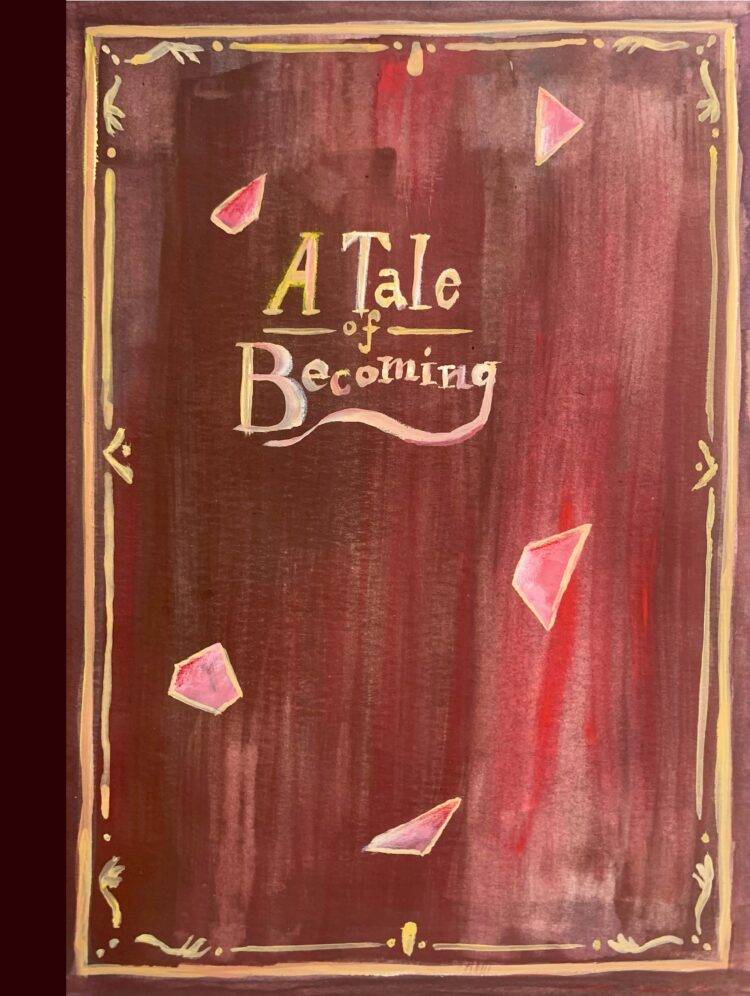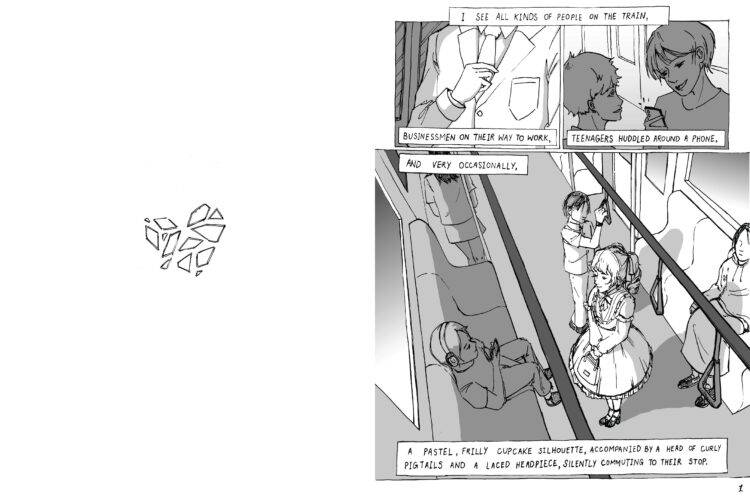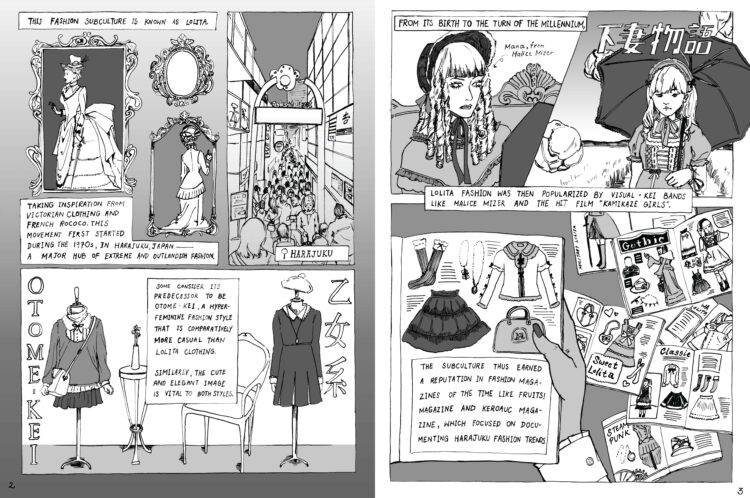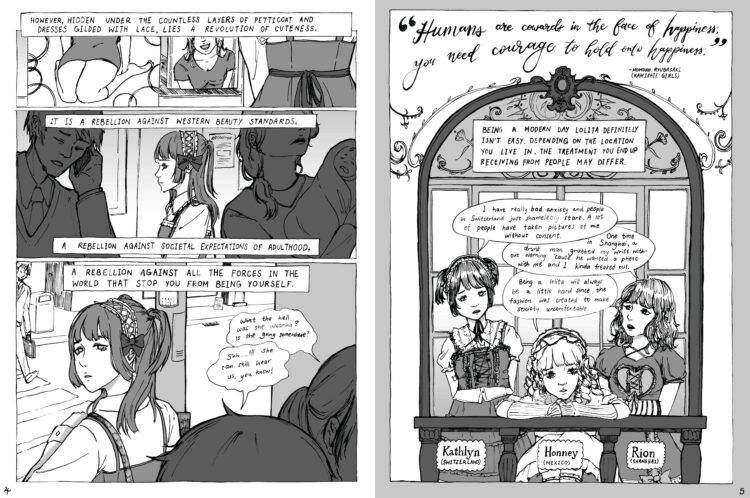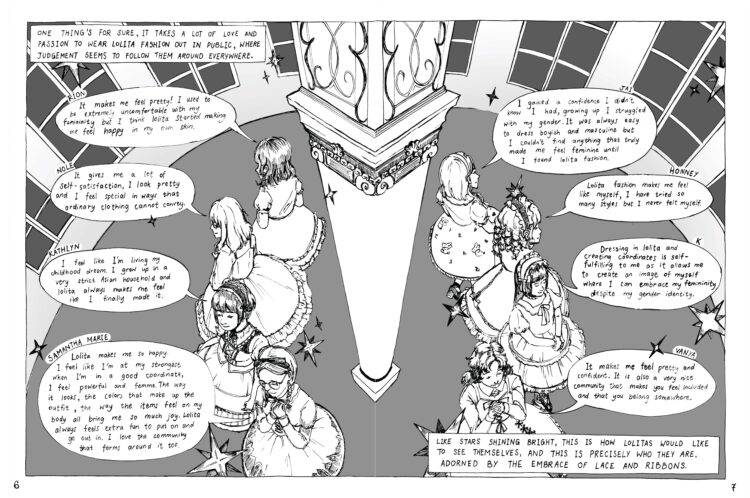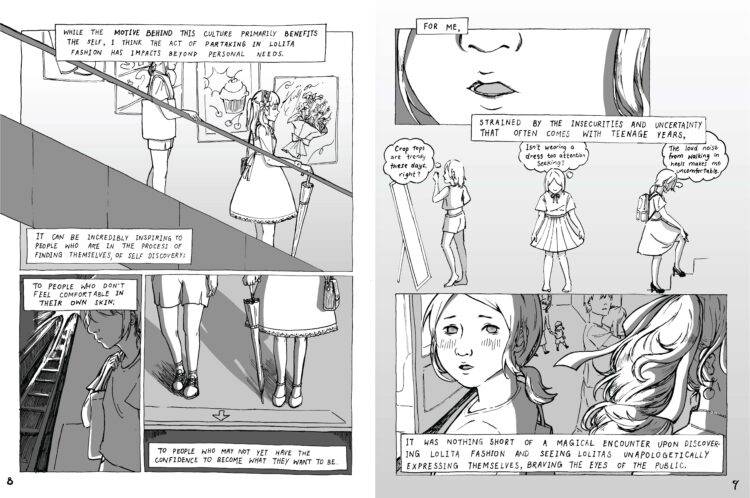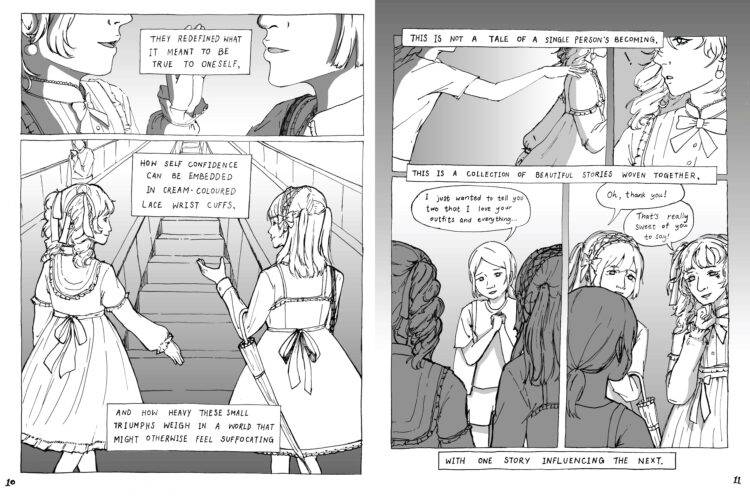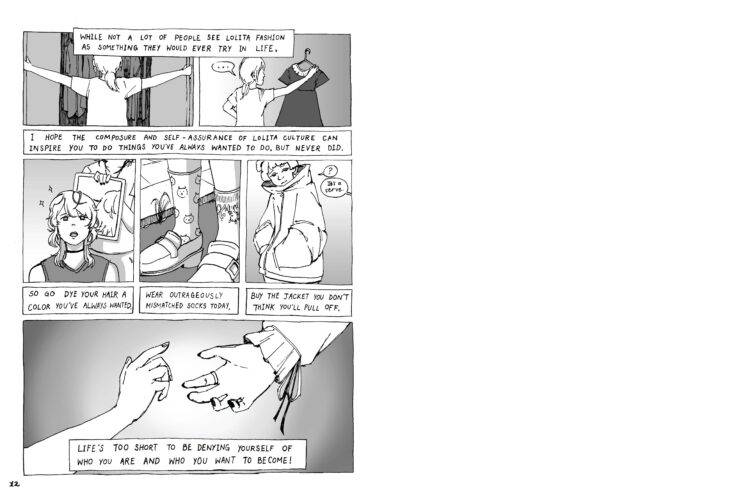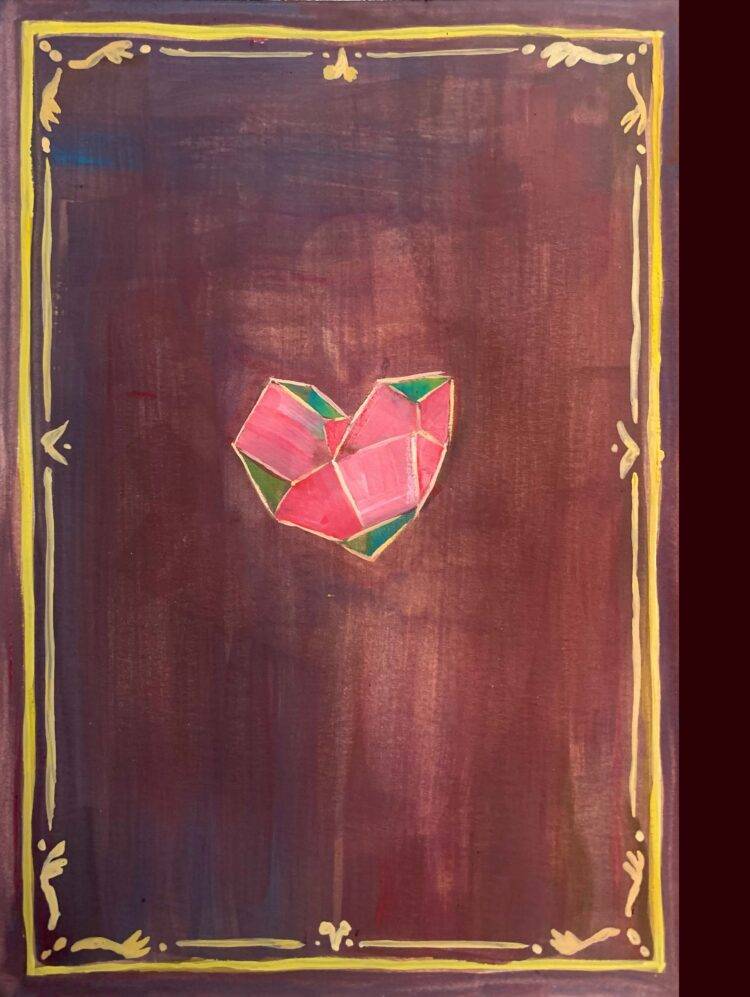Page 1:
Panel 1: A man fixing his tie
Panel 2: Two people conversing while one has a phone in their hand
Panel 3: A person in Lolita fashion standing on a train
Caption:
I see all kinds of people on the train, businessmen on their way to work, teenagers huddled
around a phone, and very occasionally, a pastel, frilly cupcake silhouette, accompanied by a
head of curly pigtails and a laced headpiece, silently commuting to their stop.
Page 2:
Panel 1-2: Women in Rococo fashion in elaborate picture frames
Panel 3: A shot of Harajuku, Japan
Panel 4: Two dress forms in different outfits in Otome-kei
Caption: This fashion subculture is called Lolita. Taking inspiration from Victorian clothing and
French Rococo, this movement first started during the 1970s, in Harajuku, Japan – a major hub
of extreme and outlandish fashion. Some consider its predecessor to be Otome-kei, a hyper
feminine fashion style that is comparatively more casual than Lolita fashion. Similarly, the cute
and elegant image is vital to both styles.
Page 3:
Panel 1: Image of Mana from the band Malice Mizer
Panel 2: Image of a character from the film Kamikaze Girls
Panel 3: A hand holding a fashion magazine with many other magazines in the background
Caption: From its birth to the turn of the millennium, Lolita fashion was then popularized by
Visual Kei bands like Malice Mizer and the hit film “Kamikaze Girls”. The subculture thus earned
a reputation in fashion magazines of the time like Fruits! Magazine and Keroauc Magazine,
which focused on documenting Harajuku fashion trends.
Page 4:
Panel 1: A girl in Lolita fashion looking at clothing poster
Panel 2: The girl walks down the street with other people
Panel 3: The girl turns her head back after listening to some people make comments about her
– “What the hell was she wearing? Is she going somewhere?”, “Shh…!!! She can still hear us,
you know!”
Caption: However, under the countless layers of petticoats and dresses gilded with lace, lies a
revolution of cuteness. It is a rebellion against western beauty standards, a rebellion against
societal expectations of adulthood, a rebellion against all the forces in the world that stop you
from being yourself.
Page 5:
Panel 1: Interviewees standing on a balcony
Caption: “Humans are cowards in the face of happiness, you need courage to hold onto
happiness” -Momoko Ryugasaki (Kamikaze Girls)
Being a modern day Lolita definitely isn’t easy. Depending on the location you live in, the
treatment you end up receiving from people may differ.
Kathlyn (Switzerland): “I have really bad anxiety and people in Switzerland just shamelessly
stare. A lot of people have taken pictures of me without consent.”
Rion (Shanghai): “One time in Shanghai, a drunk man grabbed my wrist without warning ‘cause
he wanted a picture with me and I kinda freaked out.”
Honney (Mexico): “Being a Lolita will always be a little hard since the fashion was created to
make society uncomfortable.”
Page 6-7:
Panel 1: A group of people in Lolita fashion standing in a circle with their backs against each
other
Caption: One thing’s for sure, it takes a lot of love and passion to wear Lolita fashion out in
public, where judgement seems to follow them around everywhere. Like stars shining bright, this
is how Lolitas would like to see themselves, and this is precisely who they are, adorned by the
embrace of lace and ribbons.
Rion: “It makes me feel pretty! I used to be extremely uncomfortable with my femininity but I
think lolita started making me feel happy in my own skin.”
Nole: “It gives me a lot of self-satisfaction, I look pretty and I feel special in ways that ordinary
clothing cannot convey.”
Kathlyn: “I feel like I’m living my childhood dream. I grew up in a very strict Asian household and
lolita always makes me feel like I finally made it.”
Samantha Marie: “Lolita makes me so happy. I feel like I’m at my strongest when I’m in a good
coordinate, I feel powerful and femme. The way it looks, the colors that make up the outfit, the
way the items feel on my body all bring me so much joy. Lolita always feels extra fun to put on
and go out in. I love the community that forms around it too.”
Jai: “I gained a confidence I didn’t know I had, growing up I struggled with my gender. It was
always easy to dress boyish and masculine but I couldn’t find anything that truly made me feel
feminine until I found lolita fashion.”
Honney: “Lolita fashion makes me feel like myself, I have tried so many styles but I never felt
myself.”
K: “Dressing in lolita and creating coordinates is self-fulfilling to me as it allows me to create an
image of myself where I can embrace my femininity despite my gender identity.”
Vanya: “It makes me feel pretty and confident. It is also a very nice community that makes you
feel included and that you belong somewhere.”
Page 8:
Panel 1: A lolita and another person are going down the escalator
Panel 2: An incoming train is arriving at the platform
Panel 3: The person and the lolita are waiting by the platform
Caption: While the motive behind this culture primarily benefits the self, I think the act of
partaking in Lolita fashion has impacts beyond personal needs. It can be incredibly inspiring to
people who are in the process of finding themselves, of self discovery; to people who don’t feel
comfortable in their own skin; to people who may not yet have the confidence to become what
they want to be.
Page 9:
Panel 1: Closeup of the person’s face
Panel 2: The person trying on different clothes saying, “Crop tops are trendy these days, right?”,
“Isn’t wearing a dress too attention seeking?”, “The loud noise from walking in heels makes me
uncomfortable.”
Panel 3: Another lolita exits the train and passes by the person
Caption: For me, strained by the insecurities and uncertainty that often comes with teenage
years, it was nothing short of a magical encounter upon discovering lolita fashion and seeing
Lolitas unapologetically expressing themselves, braving the eyes of the public.
Page 10:
Panel 1: The two lolitas greet each other
Panel 2: The two lolitas go up the escalator
Caption: They redefined what it meant to be true to oneself, how self confidence can be
embedded into cream-colored lace wrist cuffs, and how heavy these small triumphs weigh in a
world that might otherwise feel suffocating.
Page 11:
Panel 1: The person reaches out her hand to one of the Lolitas
Panel 2: The lolita turns her head around
Panel 3: The person says, “I just wanted to tell you two that I love your outfits and everything.”
Panel 4: The lolitas reply saying, “Oh, thank you!” and “That’s really sweet of you to say.”
Caption: This is not a tale of a single person’s becoming, this is a collection of beautiful stories
woven together, with one story influencing the next.
Page 12:
Panel 1: The person opening their closet
Panel 2: The person holds out a dress on a hanger
Panel 3: A person with a hairdresser behind them holding up a mirror
Panel 4: Legs with mismatched songs
Panel 5: A person with a big jacket, and someone saying, “It’s a serve” outside the frame.
Caption: While not a lot of people see lolita fashion as something they would ever try in life, I
hope the composure and self-assurance of lolita culture can inspire you to do things you’ve
always wanted to do, but never did. So go dye your hair a color you’ve always wanted, wear
outrageously mismatched socks today, buy the jacket you don’t think you’ll pull off. Life is too
short to be denying yourself of who you are and who you want to become!



